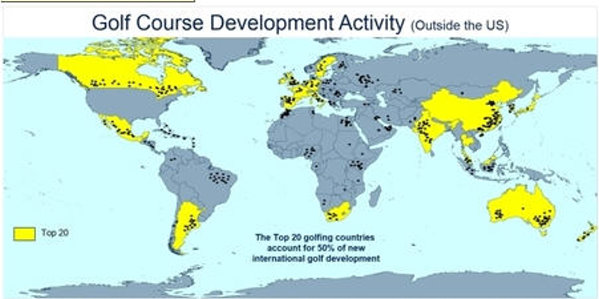
Since the announcement that golf would make its return to the Olympic Games at Rio de Janeiro in 2016, many in the golf business have speculated about the potential impact the game’s inclusion would have on the growth of golf in South America and around the world. And if golf development and participation do expand as a result of the worldwide exposure and potential increased government support given the sport, will we be able to measure and track this growth? (this report courtesy of NGF)
The R&A and the National Golf Foundation (NGF) were concerned that the answer to this question was “no” – that golf lacked a method of accurately tracking the global growth of the game. After much deliberation on how this could be accomplished, the R&A and NGF agreed that tracking worldwide golf course supply would provide a reasonable and acceptable proxy for golf participation and the growth of the game itself. Thus, the International Golf Facility Database project was conceived.
In late 2010, with the support of the R&A and 15 of golf’s leading companies, NGF undertook the ambitious task of developing a definitive worldwide database of golf facilities. It has proved to be an arduous and painstaking process to identify, through multiple sources and methodologies, all existing golf facilities and new projects. However, the effort was ultimately very productive and rewarding, as the information gathered has been standardized into a single, accurate and comprehensive database of the world’s golf courses. Though the project is ongoing and will require continuous tracking of information on existing and new golf facilities being planned or constructed, golf now has a tool that can be used to measure the game’s overall size and growth.
How Big is Golf?
Through September 2013, more than 18,350 golf facilities* in 200 countries outside the United States have been identified. While the vast majority of the world’s golf courses have been identified and entered into the database, new courses continue to be found.
The project has confirmed that golf is widely dispersed, but highly concentrated. The U.S. contains about 47% of the world’s golf facilities, and North America about 54%.
Other interesting findings include:
- Outside the U.S., 70% of courses are located in just 10 countries
- 20 countries hold 85% of supply
- After the top 20 countries, the average number of facilities per country is only 15
- Only 8 countries have more than 500 golf facilities
How and where is Golf Growing?
We’ve seen where golf exists today. Let’s take a look at where golf is growing, and how this growth is manifesting itself outside the United States. Research has uncovered approximately 270 projects that are currently under construction and another 405 golf facilities that are in advanced planning. Additionally, another 328 or so are in preliminary planning phases or on hold. These new projects comprise the development “pipeline” and represent roughly four to five years of growth.
To put this new growth in perspective, consider the following:
- Overall, there are 100 to 150 new courses opening per year worldwide.
- Net growth, excluding the U.S., represents about 1% annual increase in supply.
- If all 675+ projects in planning and under construction were completed, they would increase the international supply by about 2.5%.
As with existing golf course supply, new course development is widely dispersed, though not to the same degree. The top 20 countries account for roughly half of all new development activity. Remember that those same countries represent 85% of existing supply. Thus, golf is spreading disproportionately away from the developed golfing countries.
Where is Golf Contracting?
The game is contracting primarily in countries where golf is already highly developed, and where recent growth in golf course supply outpaced growth in the number of golfers. In these countries, such as Japan, Canada, Australia, UK, and the U.S., golf is undergoing a correction between golf course supply and demand.
The U.S. represents the most obvious example of this kind of correction. Over the 20-year period from 1986 to 2005, the U.S. saw more than 4,500 golf courses open. However, there subsequently has been a net reduction of about 500 18-hole equivalent golf courses, equating to a decline of about 3.3% from the peak supply year of 2005.
What Does this Mean for Golf Across the Globe?
Taking into account the corrections being experienced in some of the most developed golf countries, we estimate that the net change in the annual growth of golf globally is negligible at this time. However, though international course openings are generally being offset by course closures in other places, golf is growing.
Rather than focus on the marginal overall growth of golf, it is important to understand that golf is spreading across the globe. However, some question whether international growth is happening in a way that will be most beneficial to the game in the long run. For instance, roughly two-thirds of new golf construction is tourism related. And while new resort golf may be great for the overall economies of places such as Hainan Island in China, the Caribbean, Central America and Mexico, this type of development may not be the impetus for meaningful growth of the game among the residents of those countries. (China, as an example, might be better served by more affordable golf facilities, rather than new high-end resort courses, to foster golf demand among its rapidly growing middle class). The NGF will explore these issues in an upcoming edition of the ‘Dashboard’.
*Because many countries have unique classification systems for golf facilities, it was necessary to standardize the definitions of golf facilities and golf courses so that the international database is consistent across countries. In summary, golf facilities can comprise multiple golf courses (think Bethpage State Park, Torrey Pines, etc.).
National Golf Foundation www.ngf.org

